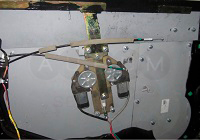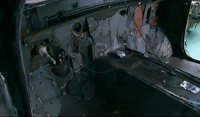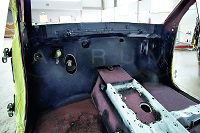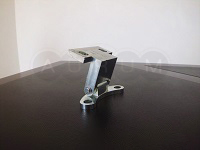The nature of attacks have changed over time. More and more attacks start with an explosion – it is estimated - that in 2012 more than a half of ballistic attacks started with a blast.
Bombs are often detonated in crowded places – in countries like Iraq and Afghanistan blast attacks are common - so sitting in a top quality blast-resistant vehicle is the only way to maximize the chances of survival. Bombs carried by suicide attackers usually do not exceed 15 kg of explosive; a correctly armored vehicle can sustain that, yet vehicles from the majority of the manufacturers would give little chance of survival.
Several aspects of armoring design are extremely important to enable a vehicle to withstand blasts:
The vast majority of manufacturers complete the armoring of the doors in the same way – by placing several plates of armor steel inside the door.
Stick-welded 2 plates

Several plates fixed by bolts and stick-welding
This method allows the original plastic door panels to be kept and requires little time and effort. The problem is, -that there is no way such a door would withstand any serious side explosion – the welding, especially stitch-welding, simply cannot hold plates together strongly enough, so during the first milliseconds of an explosion these plates would detatch and fly inside the vehicle.
Fitting armor plates inside the doors also means leaving ballistic gaps when the door frames are from 45°.
Even worse, some manufacturers do not weld the plates at all – they just fix them in with bolts.

Armor fixed using bolts only
Obviously even a weak blast wave will tear such a structure apart. Besides that, bolts and joints expose additional ballistic gaps.
Without exceptions all customers who understand the importance of correct construction in armored vehicles require that the armoring of a door is done using a single armor plate:

Armoring using only one armor plate - this is how it should be constructed
Needless to say this is the only way that we armor doors.

Very few manufacturers bother to replace or reinforce the door frames – they just install bullet-proof glass into the standard frames:
Although it is the fastest and the easiest way of installing bullet-proof glass, the problem is the same – such doors cannot withstand any significant side explosion – the standard frame is not designed to hold a blast wave, and the bullet-catchers in the doors frames cannot alleviate the situation.
Absolutely all the vehicles that were certified had reinforced door frames. There is no way around it. The drawback of reinforced door frames is that as a rule they look very massive so it is obvious that the vehicle is armored. The reason for this is that nearly all manufacturers reinforce the frames from the outside:



In our vehicles the frames are installed inside so the exterior of the vehicle does not differ much from the standard one.


Nearly all manufacturers use small plates of “mosaic” form, welded to each other, when a complex surface like a firewall should be properly armored:

Firewall made by one of our competitors
Only a few manufacturers in the world use the technology of hot-forming armor steel. This technology allows parts from armor steel to be manufactured exactly in the shape needed:

Large parts made without welding provide incomparably better blast protection – the simulation shows that even properly made welding seams hold only as little as 30% of the stress that a solid plate can hold.

An armored door is much heavier than an original one, so the door hinges must be reinforced. The cheapest way to achieve this is to weld some plates into it. This is the solution that can be commonly seen in cheaper armored vehicles:

Standard “reinforced” hinge
Although this solution is very cheap it has two significant drawbacks:
- the time the door starts trembling as some parts of the hinges remain not reinforced;
- a significant blast can simply tear the door away – standard hinges are not designed to have high tensile strength.
Another common solution is to use hinges welded from several plates. Such hinges are free from the first issue – usually they are robust enough to hold the weight of the door – but still cannot keep the door during the impact of the blast wave.
To overcome both these problems a hinge should be milled from a single piece of steel:

A hinge milled from a single piece of steel
Such hinges are more expensive than welded ones but only they can hold the doors during a significant blast.

Three people including Pakistan Chief of Security were killed on 10th of July, 2013 after a suicide bomber attack.
The explosion was not strong – there was no crater on the road, the wheels were not damaged (in case of a strong explosion the blast wave pushes the vehicle away so fast that wheels come away from the tires), the standard body was not pulled down.
Nevertheless this vehicle failed to protect its passengers, which is not surprising considering the nature of the damage to the vehicle:
- the glasses were blown away - apparently they were not fixed appropriately
- one door was torn away completely - the hinges did not withstand the load
- the armor just fell out of the doors
The passengers would not have died if this vehicle had had a proven protective cocoon

During the testing and certification in Germany our vehicle withstood the following blasts – you can see videos here.
- An explosion of 6 kg TNT under the wheel. There would be no injuries to the occupants of the vehicle. This blast imitates a driving over an anti-tank mine and is the most serious test for vehicles. As of 2013 there are only a few companies in the world whose vehicles under 8 tons could sustain such a blast.
- A directional blast of 15 kg TNT on the side, from 2 m distance, elevation 1 m. There would be no injuries to the occupants of the vehicle. This blast imitates a roadside improvised explosive device (IED) – a common threat in many countries of Middle East and Africa. A directional blast at 2 m is much stronger than non-directional at 4 m – you can see more information here.
- An explosion of DM 31 anti-personnel mine under the floor. There would be no injuries to the occupants of the vehicle.
- A simultaneous explosion of 3 hand grenades DM51 under the floor. There would be no injuries to the occupants of the vehicle. This exceeds BRV 2009 requirements, which define a blast of 2 hand grenades.
- A simultaneous explosion of 3 hand grenades DM51 on the roof. There would be no injuries to the occupants of the vehicle. This exceeds BRV 2009 requirements, which define a blast of 2 hand grenades.
You can see more details on different blast protection levels here. The certification has confirmed that our vehicles provide fully reliable protection. There are only a couple of companies in the world who are able to produce armored vehicles with this level of protection against blasts.
